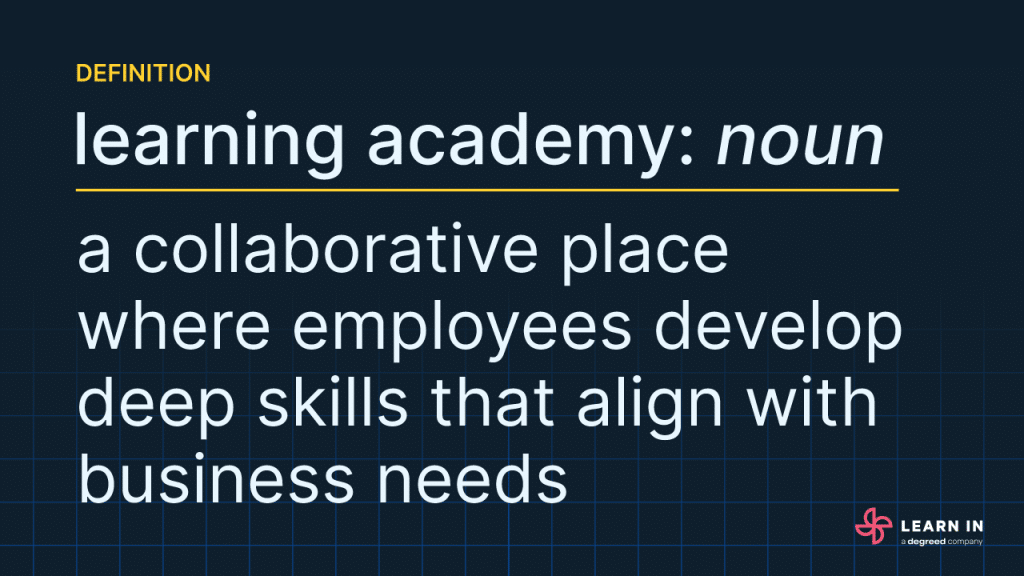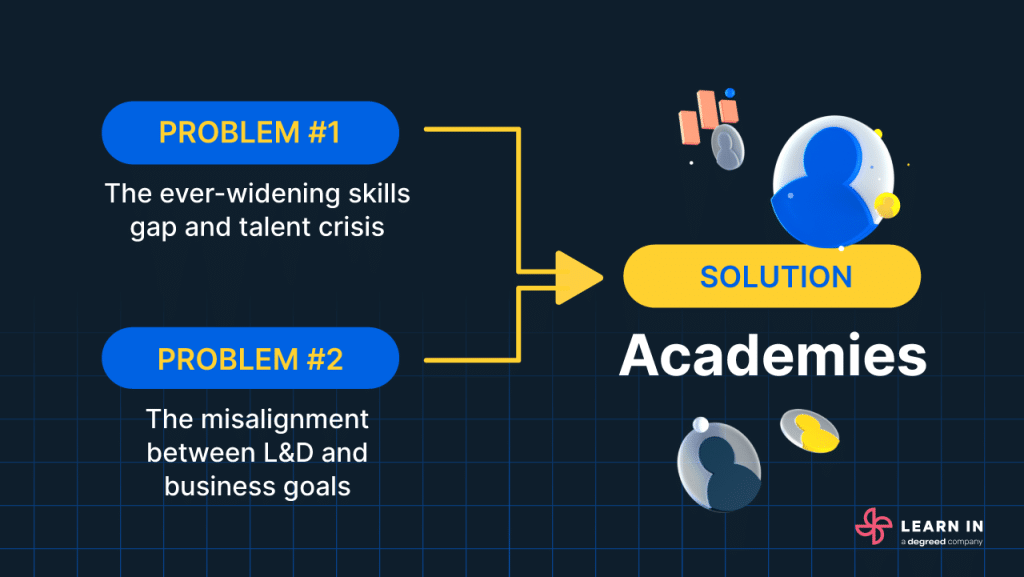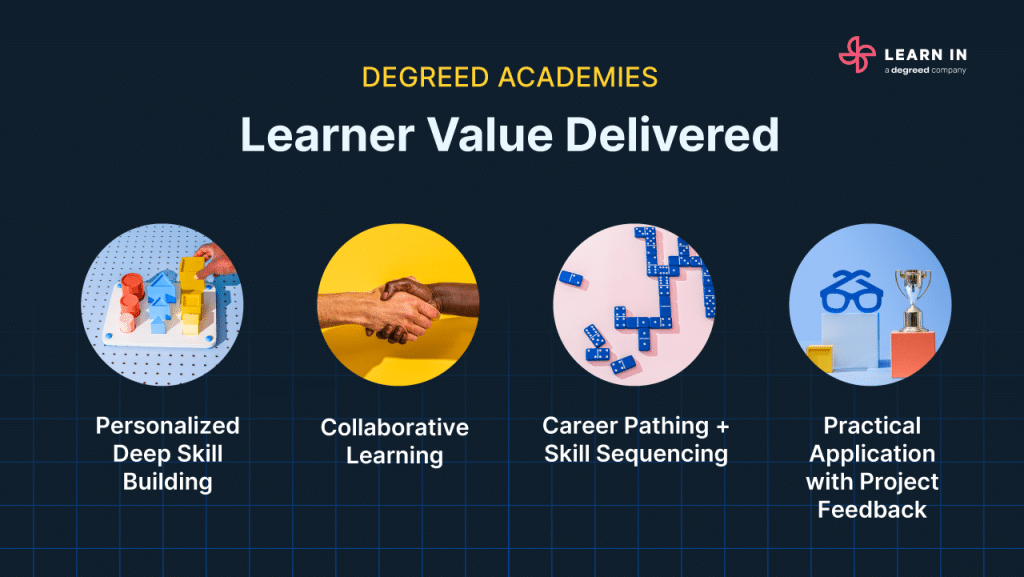Academies, according to thought leader Josh Bersin, are the “next big step in corporate learning.” Why? Well, academies promise a solution to managing and closing that ever-widening skills gap.
This means that any L&D and HR leader worried about the talent shortage — essentially everyone — should invest some time and effort in learning about and leveraging academies to close the skills gap.
Whether you’re in the process of building your own academy or you just heard the word mentioned at the L&D and HR water cooler, this article will tell you everything you need to know — from the basics like definitions and use cases to more practical how-to’s designed to help you build or improve your own internal academies.

Table of Contents
- What are learning academies?
- What major problems do learning academies solve?
- Why are learning academies a good solution for deep upskilling?
- Who can (and should) build learning academies?
- What are some additional benefits of building learning academies?
- What are some basic tips to build your own learning academies?
What are learning academies?
A learning academy is a collaborative place where employees develop deep skills that align with business needs.
It’s possible you’ve already heard about learning academies. The idea appeared on the radar of HR & L&D leaders a few years ago, when Bersin used the term to describe “an emerging zeitgeist in corporate learning and development (L&D).”

While the idea itself isn’t new, it signifies a “new breed of platforms” in the learning tech marketplace. In fact, these platforms are so new that the nomenclature of “learning academies” isn’t even fully baked. The “academies” part remains constant but, depending on who’s using the term, a different modifier can wind up at the front of it: learning academies, capability academies, training academies, skills academies or talent academies. Whatever word someone places in front of it, the basic concept driving learning academies — a collaborative place to develop skills that align with business needs — remains the same.
Okay, enough with semantics. Now let’s discuss why academies are so damn important.
What major problems do learning academies solve?
Don’t be fooled by the simplicity of the learning academy definition: a collaborative place where employees develop deep skills that align with business needs. This definition disrupts the current learning tech marketplace by addressing two key problems:
- The ever-widening skills gap and talent crisis
- The misalignment between L&D and business goals
These two issues have baffled L&D leaders for years. Finally, a promising solution has arrived on the ed tech scene.

Problem No. 1: The ever-widening skills gap and talent crisis.
Even before the disruption by generative AI, the World Economic Forum in 2020 predicted that by 2025 the unrelenting pace of technology will displace 85 million jobs, create 97 million jobs, and require half of all employees to reskill.
McKinsey & Company already reports that, as predicted, 87% of companies are experiencing a talent shortage. But the skills pinch is happening despite business leaders working hard to fill the skills gap. Companies threw a boatload of money at the problem in the past decade.
In 2010, companies spent 271 billion on corporate training globally, and that spending increased by 37% in ten years. According to Training Industry, companies in 2020 will spend a whopping $357 billion on training and learning programs. And in the United States alone, training expenditures passed the $100 billion mark in 2021-2022.
What do companies have to show for their spending sprees? Not much. As companies spent billions of dollars, the percentage of CEOs worried about skill availability only increased. It actually increased at a faster rate than company spending: it went from 53% in 2012 to 79% in 2019. (With the arrival of generative AI, who knows how much that percentage increased?!)
Clearly, the learning solutions that companies spent billions on in the past decade didn’t fill their skill gaps. But don’t lose heart — now there’s a viable solution for keeping your company stocked with talent.
Solution: How academies keep your company stocked with talent.
Academies enjoy a long and successful track record when it comes to developing and delivering internal talent. A famous example comes from General Electric: After building skills at the company’s physical academy in the 1950s, Reginald Jones went on to become a future GE CEO.
Bersin also lauds his old-school academy experience at IBM in the 1980s:
“We had a sales academy like none other. I spent years in sales training and learned more about customers, selling practices, and products than at any other time in my life. (My son just spent a year in the SAP Sales Academy, and it set him off on an incredible career.”
— Josh Bersin
So historically, learning academies have been successful. And while the GE and IBM academies were brick-and-mortar buildings, today companies can continue to cultivate talent with the same principles using the latest technology. And they continue to remain successful. Bersin identifies some of these successful modern-day versions:
- Comcast, Academy of Customer Service
- Comex, Supply Chain Academy and Safety Academy
- Visa, FinTech Capability Academy
- Capital One, Cloud, Digital and Cybersecurity Academy
- Ford, Autonomous Vehicle Academy
Problem No. 2: The misalignment between L&D and business goals.
Along with the widening skills gap, another difficulty plaguing HR and L&D leadership is aligning learning initiatives with company goals. Because of the endless learning options provided by podcasts, conferences, books, and boot camps, it’s easy for well-intentioned employees to spend learning benefits on skills that don’t align with company needs.
For example, employees using one of the many self-directed learning platforms often make learning decisions with limited to no guidance from C-suite leaders. In an article for Training Industry about academies, Yael Gilbo Kaufmann, Co-founder of Learn In, observes that “self-directed learning requires too much guesswork for employees: ‘Would I be more valuable to my company if I read this article or watch this video on digital analytics?’”
Just how far off is the alignment? In the Brandon Hall Group 2020 Learning Strategy Study, almost every company (87%) expressed the need to align learning and goals, but only 13% said they were capable of doing it. What an extrodinary statistic!
Obviously, before companies start investing in upskilling, they need a learning solution that re-aligns learning objectives with business objectives.
Solution: How academies drive business objectives.
For upskilling to align with company goals, academies must provide the connective tissue between learning platforms, data, and people (e.g. other departments, C-suite leaders, managers, and employees).
The corporate academy is a storied 20th-century U.S. institution — starting in the mid-1950s when the president of GE, Ralph Cordiner, bought land and established a brick-and-mortar university to develop managers. As you might expect, and with so much overhead spent to run brick-and-mortar academies, leadership in the old days insisted on playing a key role in shaping curricula and goals.
Today’s modern academies continue this tradition. Bersin explains that academies “should be led by a business leader, not an L&D professional.” This, he says, could be the CIO, CEO, or CFO at the helm of their academies.
But it’s not just having the C-suite over the academy that ensures alignment. Today, modern academies utilize technology, like integrations, to promote quick and easy communication between software programs, access skills data, and connect everyone within the company. More easily and effectively than ever, leadership can now provide insightful unique perspectives on the skills that are needed and help design the learning pathways to fill those needs.
Why are learning academies a good solution for deep upskilling?

As companies spent those billions of dollars over the last decade, many legacy learning solutions attempted to use their software to bridge the skills gaps. As discussed, it didn’t work. So why will learning academies get the job done?
The builders of academies understand that deep upskilling is a different critical learning need than training or everyday learning. Deep upskilling requires different pedagogical strategies. Deeper upskilling requires a richer, longer, and more intensive learning experience. To do that, academies focus on a learning methodology that promotes deeper, more critical skill learning and supports developing those skills to pursue a career path.
Three learning strategies enable academies to deliver deep skill-building:
- Collaborative learning
- Career pathing and skill mapping
- Practical application and feedback

Collaborative Learning
Academies — at their core — are collaborative. It specifically refers to a class of learning methods based on traditional in-person learning models, which are often executed in groups or cohorts. After all, blended learning has long been regarded as one of the most effective learning models for high-impact learning topics. The social dynamic of learning from peers and subject matter experts lends context, sparks discussions, and offers coaching and feedback.
Especially with generative AI changing the world of skills, humans must fill in the gaps of deeper learning around more complex or human-centric skills like critical thinking, effective decision-making, communication, and problem-solving. So it’s a win-win for any deep skill building to require employees to flex interpersonal and communication skills.
Career Pathing and Skill Mapping
Academies think big. Careers are built by performing a cluster of skills — not just one skill. Too often legacy learning programs only focus on learning a skill. Or if an employee does learn a cluster of skills, those skills don’t necessarily relate to a clear career path.
Academies use an infrastructure that looks beyond just “a” skill and toward actual career development. With the right academy program, academy participants can identify a career path and then use the academy program to identify the skills they need to get there.
Practical Application and Feedback
Developing a career require practical experience. Most legacy solutions today focus on knowledge, but they don’t ask learners to apply that knowledge. This leads to the classic situation where someone can know everything about dietary science and weight lifting, but they don’t have any practical experience. To be an expert, and to develop deep skills that go beyond knowledge, they must go to the gym regularly, lift weights, and eat healthily. They need to practice and perfect their actual skills.
To build tangible skills, academies facilitate opportunities for employees to balance practice through individual and team projects. To further enhance and reinforce that experience, academies use coaching, peer and expert feedback, and assessments.
Who can (and should) build academies?
Sold on academies and want to build your own? Well, you’re in luck. Now more than ever, any company, no matter the size or industry, can build its own academies.
The list of academy builders comprises the who’s who of the business world: Google, AT&T, Amazon, Microsoft, GE, and more. And while seventy years ago only the most rich and well-resourced companies could afford these expensive and resource-heavy institutions, today you just need the right technological platform.
Technology democratized learning academies for all businesses. So don’t let the list of academy users intimidate you — let it inspire you! You can (and should) build your own academies. It’s affordable and attainable.
What are some additional benefits of building internal academies?
Keeping your company well-stocked with talent is critical, but there are additional benefits you can enjoy by building your own academies. Investing in internal academies will:
- Reduce costs
- Boost retention and engagement
- Provide dexterity for future skilling

Reduce Costs
You can reduce costs in two ways by building internal academies. First, by building your own internal academies you save the money you’d potentially spend hiring an outside agency. Outside agencies focusing on talent development cost a bundle. On top of that initial fee, they can charge extra to customize and tailor their standard content so it aligns with your company goals.
Second, especially in light of the current talent shortage, upskilling your employees is cheaper than externally hiring new talent. For example, a General Assembly Whitepaper reports that between recruitment fees, advertising, and other hiring expenses, it may cost a company about $30,000 to hire a middle-career software engineer. (That doesn’t even include onboarding expenses.) The whitepaper estimates that “the cost to train and reskill an internal employee maybe $20,000.” While that may not sound like much of a difference, it can save a company “as much as $116,000 per person over three years.”

Boost Retention and Engagement
According to a PEW poll, a majority of workers (63%) quit their jobs in 2021 because of low pay or a lack of opportunities to advance their careers. Many learning platforms will cite this statistic to show how employees value learning. But the statistic isn’t about learning — it’s about career growth. What builds career growth? Acquiring new skills. So not only do you save money and develop new skills-building academies, but you boost retention as well.

Provide Dexterity for Future Skilling
Filling your current skills gaps is critical, but those skills gaps will change over time. “In many ways, technology and AI are moving faster than real life,” explains Andy Bird, the CEO of Pearson. “We’re struggling to catch up, and the impact that that has on us both as individuals and as companies is the need to continually re-skill and upskill.”
The future, as Bird describes it, is unknowable. You don’t know which skills you’ll need in ten years, but you do know that you’ll be constantly upskilling and reskilling. Academies can help you recognize new skill gaps and address them as they arise. Once you’ve built an academy or two, you design an academy framework that works well for your company so you can add new ones as needs arise.
What are some basic tips to start building your own internal academies?
The obvious question is how can under-resourced L&D leaders put together the kind of flexible, talent-building academies the workforce needs? It’s not as daunting as it might seem. A mix of resources smartly deployed can make it work. Here are a few steps to get you started:
Step No. 1: Address challenges with the appropriate solution. Ask yourself if the problem requires learning, training, or skill development. Then use the right tools to accomplish those critical learning needs. There are three broad areas of skill building:
- Training to teach specific skills and processes.
- Learning that is more focused on enrichment and curiosity.
- Development that prepares employees to advance the organization.
This framework can help you differentiate some of the different needs you might have and clarify how to move forward.
Step No. 2: Provide time for upskilling. Providing time is pretty simple. Just 34% of employees are willing to upskill in their own time, while 71% will jump at the chance for paid upskilling and 64% will upskill on company time.
Step No. 3: Encourage learning in cohorts. More than 90% of employees and HR pros surveyed by Randstad said that skilling initiatives would be more effective with guidance and support. Company-led cohorts provide support and accountability and facilitate cross-training.
Step No. 4: Get the rest of the business involved. It’s important to make a business case for the talent academy. When the entire business sees the need for talent-building to enable you to compete and win the marketplace, the whole organization is energized and supports it.
To learn more tips, download a free copy of A Practitioner’s Guide: Building a Modern Academy.
A Modern Path Forward To Deep Upskilling & Business Alignment
With skills changing so quickly, companies must get this critical moment right — and fast. You can’t waste your time trying to solve the most unprecedented skill gaps with whatever learning tool you’ve used for the past ten years. You need a solution that delivers, and Academies not only deliver upskilling but they’re affordable and align upskilling with your business needs.
It doesn’t matter how you get it done. You can build your own academy with a paperclip, duct tape, and shoestring or you purchase a fancy academy platform — just build it.

